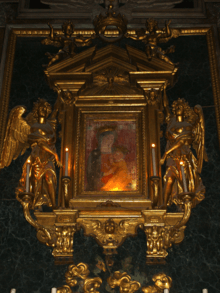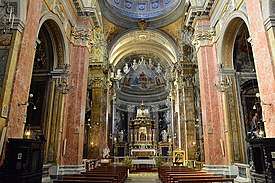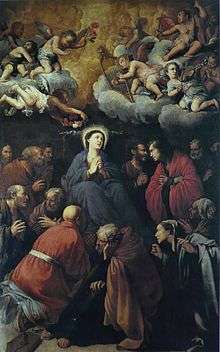Santa Maria della Scala
Santa Maria della Scala (English: Mary of the Staircase) is a titular church in Rome, Italy, located in the Trastevere rione. Cardinal Ernest Simoni took possession of the titular church on February 11, 2017.[1]
History

The church Santa Maria della Scala is located on the square of the same name. It was built under the patronage of Pope Clement VIII between 1593 and 1610 to house a miraculous icon of the Madonna. Tradition holds that a midwife with an almost dead child in her arms prayed under the stairs of a house where the image of the Madonna was present, and the child immediately revived.[2] Consecrated to Mary, mother of Jesus, the church enshrines that icon in the north transept, alongside a baroque statue of St John of the Cross. The church was built on the site of a house once bequeathed to a Casa Pia founded by Pope Pius IV in 1563 for reformed prostitutes.
The church was later granted to the Italian Discalced Carmelites. Around 1600, the friars built a monastery next door famous for containing the Papal court's 17th century pharmacy (its furnishings and equipment have been preserved). The friars prepared their medicines with herbs from the attached garden. In 1650, nearly fifty years after the buildings completion, Carlo Rainaldi designed for the church a tempietto-shaped baldachino with 16 slender jasper Corinthian columns and a high altar.
In 1849, during the last stages of the revolutionary Roman Republic's resistance to the invading French forces, Santa Maria della Scala was used as a hospital where Garibaldi's soldiers, wounded in the Trastevere fighting, were treated.
Artworks

Its choir, nave and north transept's vaults are decorated with paintings intended to resemble moldings, whilst the south transept has actual stucco relief moldings, an altar, and a relic (one of her feet) of St Teresa of Avila.

The interior has a nave with three chapels on each side. Lawyer Laerzio Cherubini had commissioned a painting from Caravaggio suitable as an altarpiece for a chapel of Santa Maria della Scala.[3][4] This was the Death of the Virgin. Rumors held that Caravaggio had used a prostitute as a model for the dead virgin. The Carmelites rejected the painting, which was then purchased by Vincenzo Gonzaga, Duke of Mantua. When Caravaggio's "Death of the Virgin was rejected" in 1606 as, it was Carlo Saraceni who provided an acceptable substitute, which remains in situ.
The church also contains The Beheading of St. John the Baptist by the Dutch painter Gerrit van Honthorst, and Giovanni Odazzi's Dream of Joseph.
San Giuseppe Hall houses a collection by Tito Sarrocchi.
See also
- Biblioteca Communale (Siena)
References
- "Avviso dell'Ufficio delle Celebrazioni Liturgiche". press.vatican.va.
- Sponzilli, Osvaldo. "Visit the Pharmacy of Santa Maria della Scala", Rome Central, February 14th, 2018
- Langdon, Helen (2000). Caravaggio: A Life. Westview Press. ISBN 9780813337944.
- Hibbard, Howard (1983). Caravaggio (1985 ed.). Oxford: Westview Press. p. 198. ISBN 9780064301282.
External links
![]()